Blanket stitch appliqué is a delightful and versatile sewing technique that adds both function and artistic flair to fabric projects.
This method involves securing one piece of fabric onto another, typically using a decorative blanket stitch to create visually appealing, sturdy edges.
It’s a favored approach for embellishing quilts, clothing, and various home decor items, allowing you to personalize your creations and showcase your creative skills.
The process combines careful design, precision cutting, and intricate stitching to seamlessly integrate fabric pieces.
With this guide, you’ll learn how to master blanket stitch appliqué, transforming your sewing endeavors into beautiful, custom-designed works of art.
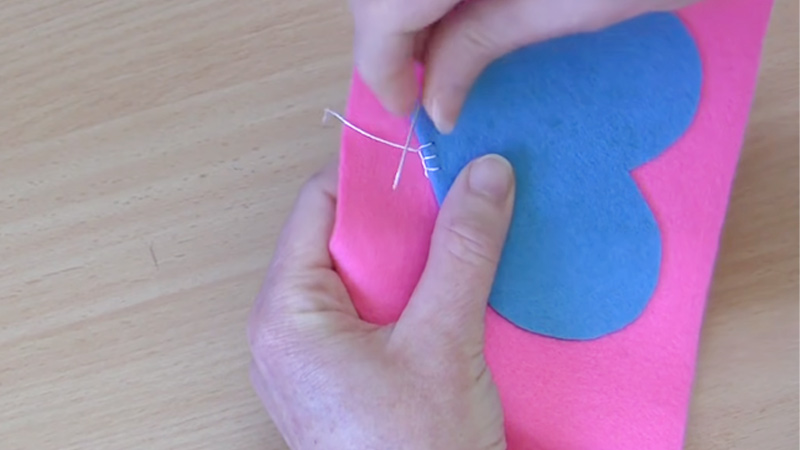
How Do You Do Blanket Stitch Appliqué?
Blanket stitch appliqué is a versatile and decorative technique in the world of sewing and embroidery.
It involves attaching a fabric shape onto another fabric using a blanket stitch, which not only secures the edges of the appliqué but also adds an attractive and textural element to your project.
Whether you’re embellishing quilts, clothing, or home decor items, here’s a step-by-step guide on how to do blanket stitch applique:
Materials and Tools:
- Fabric
- Fusible web
- Thread
- Needle
- Scissors
- Pins
Steps for Blanket Stitch Appliqué:
Step 1: Design and Cut
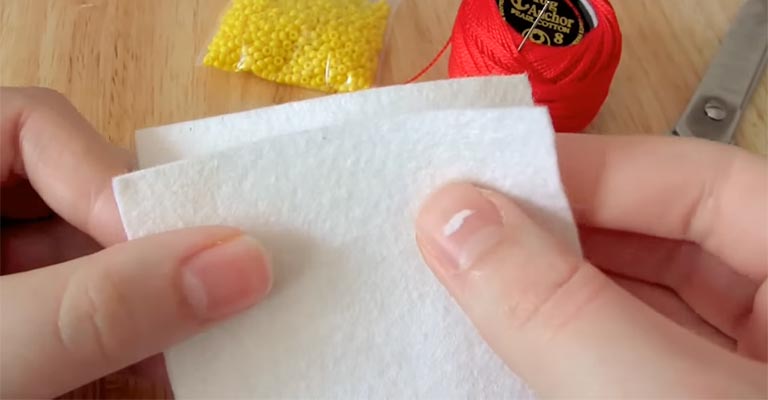
Begin by selecting the fabric for your base and your appliqué. It’s crucial to choose fabrics that either complement or contrast with each other based on your design.
Next, create or obtain a template for your appliqué shape. This template can be drawn freehand, traced onto a fusible web, or sourced from pre-made designs.
After you have the template, carefully cut out the appliqué shape, ensuring that you follow the lines closely to achieve precise edges.
Step 2: Position the Appliqué
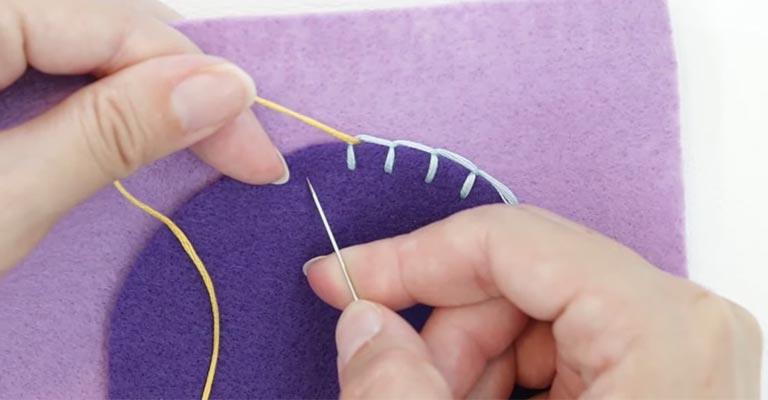
Determine where you want to place your appliqué on the base fabric. You can use pins or tailor’s chalk to mark the exact position you desire.
If your appliqué fabric has a fusible web backing, remove the paper backing, and gently press the appliqué onto the base fabric using an iron. Be sure to adhere to the manufacturer’s instructions for the correct temperature and pressing time.
Step 3: Thread the Needle
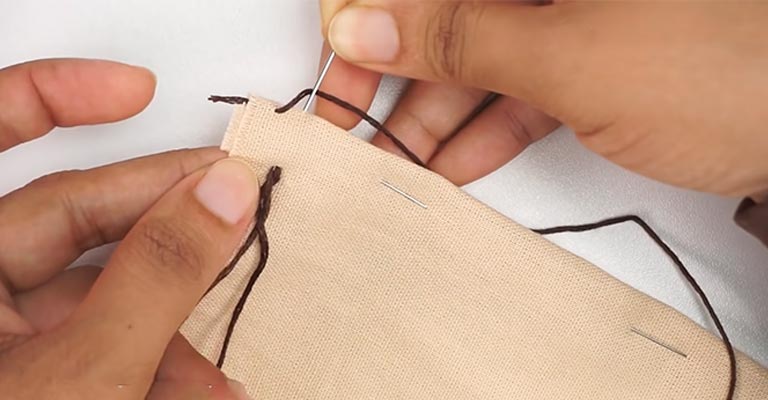
Select a thread color that complements or contrasts with your chosen fabrics. Opt for a thread that’s slightly thicker than standard sewing thread to create a more decorative effect.
Thread a small to medium-sized needle with your chosen thread and tie a secure knot at the end to prevent it from pulling through the fabric.
Step 4: Begin Stitching
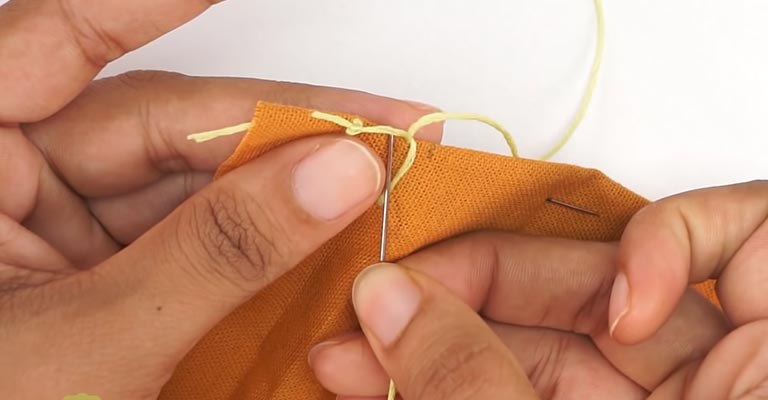
Insert the needle from the back of the base fabric to the front, just outside the edge of the appliqué. This initial insertion point marks your starting point. Gently pull the thread through, leaving a small tail on the back to secure the starting point.
Step 5: The First Stitch
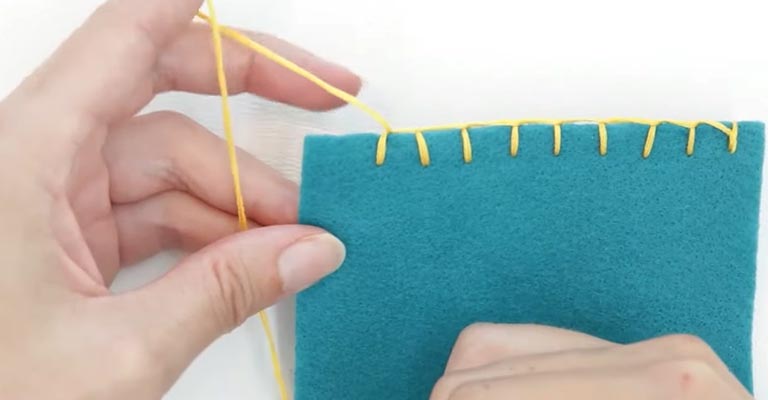
For the first stitch, take a small one from the back to the front. This time, pass the needle through the loop of the thread before pulling it tight. This creates a knot at the starting point and ensures that your stitches won’t unravel as you work.
Step 6: Blanket Stitch
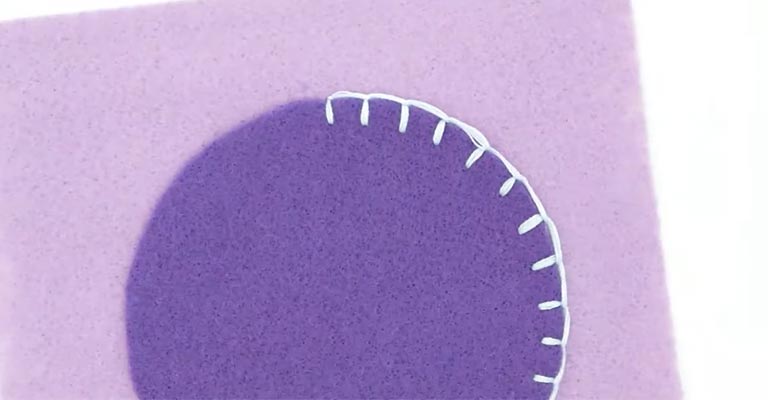
Now, insert the needle again from the back to the front, positioning it a short distance from your starting point. Bring the needle back down over the edge of the appliqué fabric, creating a loop.
Step 7: Wrap the Thread
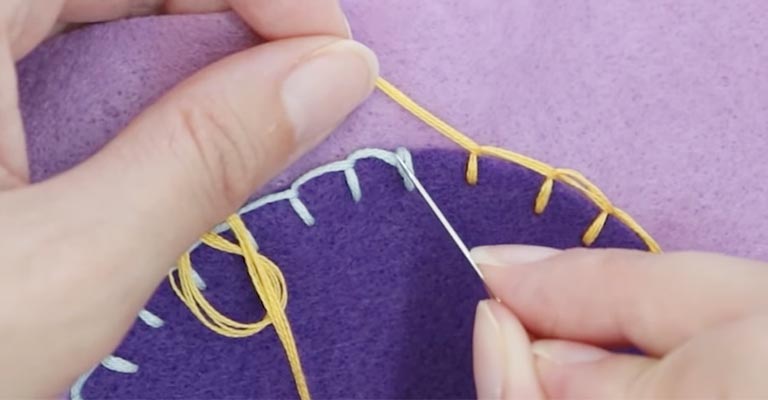
Pass the needle under the loop and pull it tight. This action secures the edge of the appliqué. Make sure that the loop is neatly wrapped around the edge of the fabric, maintaining even spacing between each stitch.
Step 8: Finishing the Stitch
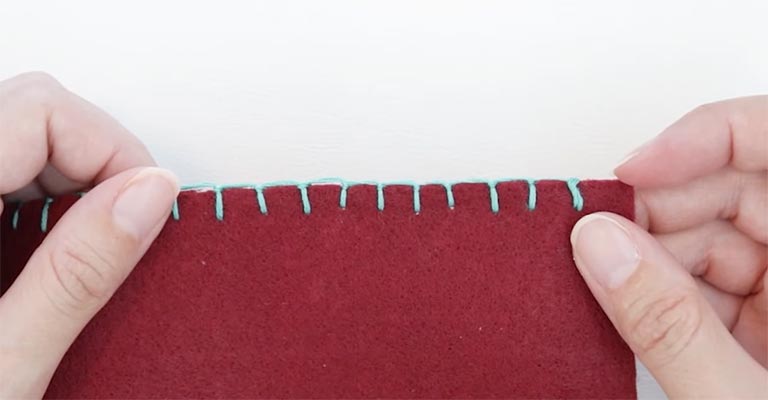
As you approach the starting point or reach the end of the appliqué shape, create a final stitch that overlaps the first one.
Pass the needle through the loop as you did before to secure the stitch. Finally, tie a knot on the back of the fabric to secure the thread and trim any excess thread.
Step 9: Trim and Tidy
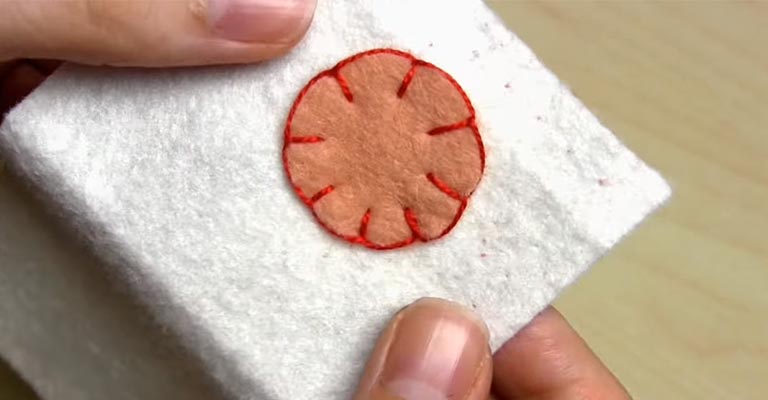
Trim any excess thread and remove any pins or markings that you used for placement. This step is essential for achieving a clean and finished appearance.
Step 10: Press if Necessary
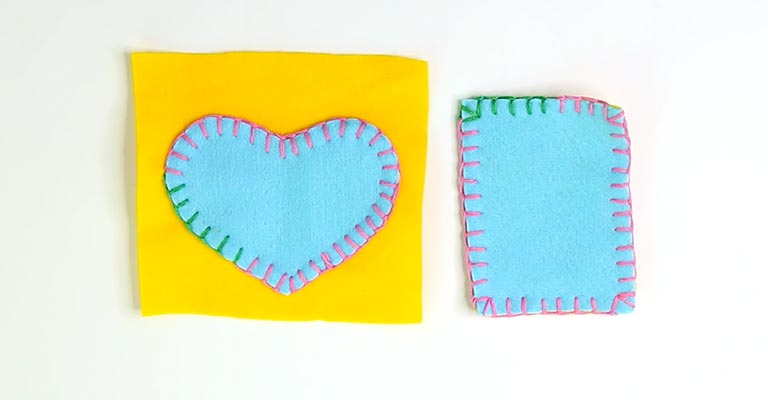
To give your project a polished look, gently press the fabric with an iron. Be sure to use the appropriate temperature settings for your fabrics and appliqué to flatten any wrinkles or creases, resulting in a professional finish.
Troubleshooting Common Issues When You Do Blanket Stitch Appliqué
Troubleshooting common issues when doing blanket stitch appliqué is an essential skill for any sewist or embroiderer. While this technique can yield beautiful results, problems can arise.
Here’s how to address some common issues:
Uneven Stitches
- Issue: Uneven spacing between your blanket stitches can detract from the finished look of your appliqué.
- Solution: Consistency is key. Before starting, consider marking your fabric with tailor’s chalk or washable fabric markers to indicate where each stitch should go. This will help you maintain even spacing between stitches and create a neater appearance.
Thread Tangling
- Issue: Thread constantly tangling or knotting can be frustrating and time-consuming.
- Solution: Begin by adjusting the thread tension on your sewing machine. If the tension is too tight, it can cause the thread to tangle. Use good-quality thread and ensure that your needle has a large enough eye to accommodate it. Check the thread path in your machine for any rough spots that might be causing snags.
Fabric Puckering
- Issue: Puckering or gathering of the fabric can occur, particularly with lightweight or delicate fabrics.
- Solution: Adjust your sewing machine’s tension to be more suitable for the fabric you’re working with. Choosing a smaller needle size for lightweight fabrics can also help reduce puckering. Additionally, using a stabilizer or interfacing underneath the fabric can provide support and prevent puckering.
Uneven Edge
- Issue: The edge of the appliqué fabric may appear irregular, affecting the overall aesthetic.
- Solution: Take extra care when cutting the appliqué shape. Use sharp fabric scissors or a rotary cutter to ensure clean edges. It’s crucial to adhere the appliqué fabric securely to the base fabric to prevent shifting during sewing. Sometimes, irregular edges can be concealed by careful stitch placement.
Skipped Stitches
- Issue: The blanket stitch may occasionally skip stitches, leaving gaps in your appliqué.
- Solution: Inspect your sewing machine needle for any signs of damage, as a damaged needle can result in skipped stitches. Ensure you’re using the correct needle type for your fabric, and double-check the threading of your machine, making sure the bobbin is correctly wound.
Fabric Fraying
- Issue: The edges of the fabric may fray easily, which can affect the longevity and appearance of your appliqué.
- Solution: To prevent fraying, apply a fabric sealant, fray check, or a thin line of clear fabric glue along the edges of the appliqué. This will help secure the fabric’s edges and maintain a clean, finished look.
7. Knots on the Back:
- Issue: Knots or tangles sometimes appear on the back of the fabric after sewing.
- Solution: To prevent knots on the back, secure your thread with a knot at the beginning and end of your stitching or use a backstitch to lock the thread in place. Additionally, be mindful of your thread tension and the path your thread takes on the backside to avoid entanglements.
Crooked Stitches
- Issue: Crooked or wobbly stitches can give your appliqué an uneven or unprofessional appearance.
- Solution: Ensure that your fabric is fed evenly through your sewing machine. You can use a quilting or embroidery foot with a guide to help keep your stitches straight. Practice your stitching technique to develop better control and consistency.
Fabric Not Adhering
- Issue: Sometimes, the appliqué fabric doesn’t adhere properly to the base fabric.
- Solution: Double-check that you’ve correctly used fusible web or your chosen adhesive according to the manufacturer’s instructions. Make sure you’ve applied heat evenly and pressed firmly to bond the fabrics effectively.
Stitches Too Tight or Too Loose
- Issue: Blanket stitches may appear either too tight or too loose.
- Solution: To achieve the desired stitch tightness, adjust the tension settings on your sewing machine. Experiment with different settings until you find the one that works best for your project. It’s helpful to test on a scrap piece of fabric to fine-tune the tension.
FAQS
What is blanket stitch appliqué?
Blanket stitch appliqué is a sewing and embroidery technique used to attach one fabric piece onto another while creating decorative, secure edges with the blanket stitch.
How do I use a blanket stitch for appliqué?
To use a blanket stitch for appliqué, insert your needle from the back to the front of your fabric just outside the edge of the appliqué shape.
Can you explain the process of doing a blanket stitch on appliqué?
Doing a blanket stitch on appliqué involves using a hand-sewing technique where you stitch around the edge of the appliqué fabric to attach it to the base fabric, creating a decorative border.
What’s the significance of appliqué blanket stitch?
Appliqué blanket stitch is a decorative sewing method that combines the art of appliqué and the functionality of the blanket stitch, resulting in beautifully finished fabric projects.
How is blanket stitch embroidery related to blanket stitch appliqué?
Blanket stitch embroidery often refers to using the blanket stitch for decorative embroidery work, while blanket stitch appliqué specifically involves using the blanket stitch to attach fabric pieces together for appliqué purposes.
Both techniques utilize the blanket stitch but serve different creative purposes.
To Recap
Blanket stitch appliqué is a captivating fusion of artistry and practicality within the realm of sewing and embroidery.
This method allows crafters to seamlessly attach one fabric piece onto another while adorning the edges with the aesthetically pleasing and robust blanket stitch.
Through careful design, precise cutting, and the intricate art of stitching, individuals can breathe life into their creative visions, adding a personalized touch to quilts, clothing, and home decor items.
By mastering the blanket stitch appliqué technique, you can not only enhance the visual appeal of your projects but also showcase your craftsmanship and attention to detail, turning everyday textiles into exquisite, custom-designed works of art.
Leave a Reply